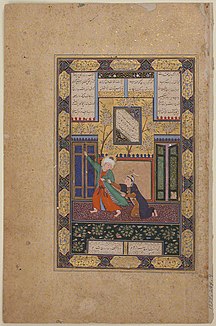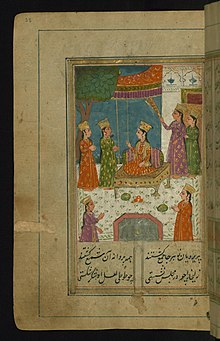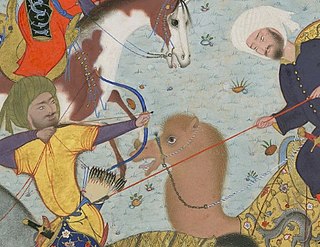Origins
Though found widely in the Muslim world, the story of Yusuf and Zulaika seems first to have achieved a developed an independent form in Persian literature around the tenth century CE: there is evidence for a lost narrative poem on the subject by the tenth-century Abu l-Muʾayyad Balkhī (as well as one by an otherwise unknown Bakhtiyārī of apparently similar date). The principal source was the Qur'an's twelfth sura, which recounts the whole of Yusuf's life, supplemented by commentaries on the Qur'an and retellings of Yusuf's life in the genre of biographies of the Prophets known as Qiṣaṣ al-anbiyāʾ , along with Syriac Christian works and (probably mostly indirectly) the Hebrew Midrash. [2]
Zulaikha's name
Neither the Qur'an nor traditions from the sunnah state that Aziz's (Potiphar) wife's name is Zulaikha. The name is derived from the poem "Yusuf and Zulaikha" by 15th century poet Jami and later medieval Jewish sources, however in the Qur'an the name is simply "ٱمْرَأَتُ ٱلْعَزِيزِ" (roman: "Amraat al Aziz") (Aziz's wife) [3] [4]
The Qur'anic account
The story of Yusuf and Zulaikha takes place in the twelfth chapter of the Qur’an, titled "Yusuf." The story plays a primary role within the chapter, and begins after Yusuf, son of Yaqub ibn Ishaq ibn Ibrahim, is abandoned and subsequently sold to an Egyptian royal guard. [5]
After reaching maturity, Yusuf becomes so beautiful that his master's wife, later called Zulaikha in the Islamic tradition, falls in love with him. Blinded by her desire, she locks him in a room with her and attempts to seduce him. [6] Through his great wisdom and power, Yusuf resists her and turns around to open the door. Upset, Zulaikha attempts to stop him, and in the process, rips the back of his shirt. [7] At this moment, Zulaikha's husband (the lord of the house and Yusuf's master) catches Zulaikha and Yusuf struggling at the door and calls for an explanation. [7] Deflecting the blame, Zulaikha tells her husband that Yusuf attempted to seduce her. [7] Yusuf contradicts this and tells the lord that Zulaikha wanted to seduce him. [8] The lord is unsure who is guilty, but a servant of the household tells him that the placement of the rip on Yusuf's shirt will tell the truth about what happened. According to the servant, if Yusuf's shirt was ripped at the front, he must have been going toward Zulaikha, attempting to seduce her. [8] On the other hand, if Yusuf's shirt was ripped from the back, he was trying to get away from Zulaikha; therefore, Zulaikha was guilty. [9] After examining Yusuf's shirt and seeing the rip on the back, Yusuf's master determines his wife is the guilty party, and angrily tells her to ask forgiveness for her sin. [10]

Later, Zulaikha overhears a group of women speaking about the incident, verbally shaming Zulaikha for what she did. [11] Zulaikha, angered by this, gives each woman a knife and calls for Yusuf. [12] Upon his arrival, the women cut themselves with their knives, shocked by his beauty. [12] Zulaikha, boosted by proving to the women that any woman would fall for Yusuf, proudly claims that Yusuf must accept her advances, or he will be imprisoned. [13]
Disturbed by Zulaikha's claim, Yusuf prays to Allah, begging Allah to make them imprison him, as Yusuf would rather go to jail than do the bidding of Zulaikha and the other women. [14] Allah, listening to Yusuf's request, makes the chief in power believe Yusuf should go to prison for some time, and so Yusuf does. [15]
Development in Arabic literature
Although Agnès Kefeli has said that "in Turkic and Persian literatures (although not in the Qur’an or the Arabic tales of the prophets), Joseph and Zulaykha do, ultimately, become sexually united", [1] : 384 their union does occur in some Arabic literature. Examples include Muḥammad al-Kisāʾī's probably eleventh-century CE Qiṣaṣ al-anbiyāʾ: here Zulaykha comes to Yūsuf during the Egyptian famine, facing starvation, whereupon Yūsuf restores her to her accustomed grandeur and marries her, and God restores her youth and beauty. Zulaykha turns out to be a virgin because her previous husband Potiphar "was impotent because he was prideful" and she bears two sons. [16] : 179–80 Another example is the probably seventeenth-century Egyptian account of Joseph edited by Faïka Croisier as L’histoire de Joseph d’après un manuscrit oriental . [17]











